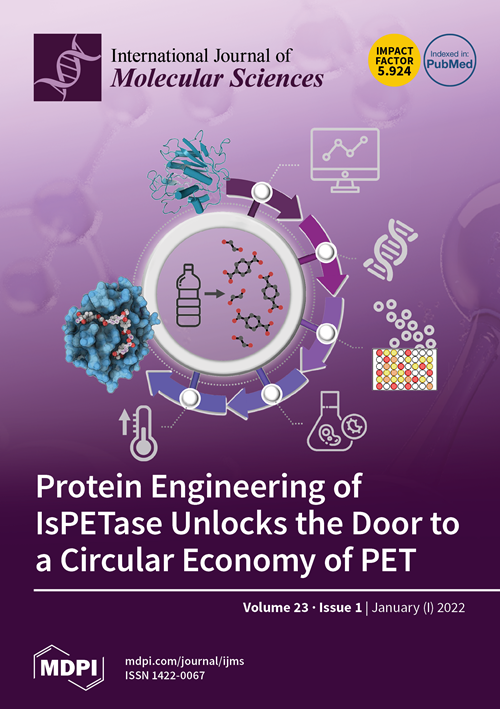牛皮癣 NF-kB 诱导的皮肤炎症中 WWOX 功能的机制研究
IF 4.9
2区 生物学
Q1 BIOCHEMISTRY & MOLECULAR BIOLOGY
引用次数: 0
摘要
牛皮癣是一种慢性炎症性皮肤病,以表皮过度增殖、角质形成细胞分化异常和免疫反应失调为特征。含WW结构域的氧化还原酶(WWOX)是一种非典型肿瘤抑制基因,可调节多种细胞过程,包括增殖、凋亡和迁移。本研究旨在探讨 WWOX 在银屑病发病机制中可能扮演的角色。免疫组化分析表明,在人类银屑病皮损和咪喹莫特诱导的小鼠银屑病模型的表皮角质细胞中,WWOX的表达均有所增加。用表达特异性 WWOX 的 microRNA 的重组腺病毒转导永生化的人类表皮角质细胞,以降低 WWOX 的表达。用 Western 印迹、实时定量反转录聚合酶链反应(PCR)和酶联免疫吸附试验检测炎症反应。在人表皮角质细胞中,WWOX 基因敲除减少了核因子-kappa B 信号传导,并降低了多聚肌苷酸[(poly(I:C)]在体外诱导的促炎细胞因子水平。此外,钙螯合剂和蛋白激酶 C(PKC)抑制剂能显著减少多聚(I:C)诱导的炎症反应。WWOX 通过调节钙和 PKC 信号在表皮角质细胞的炎症反应中发挥作用。以 WWOX 为靶点可能是未来治疗银屑病的一种新方法。本文章由计算机程序翻译,如有差异,请以英文原文为准。
Mechanistic Investigation of WWOX Function in NF-kB-Induced Skin Inflammation in Psoriasis
Psoriasis is a chronic inflammatory skin disease characterized by epidermal hyperproliferation, aberrant differentiation of keratinocytes, and dysregulated immune responses. WW domain-containing oxidoreductase (WWOX) is a non-classical tumor suppressor gene that regulates multiple cellular processes, including proliferation, apoptosis, and migration. This study aimed to explore the possible role of WWOX in the pathogenesis of psoriasis. Immunohistochemical analysis showed that the expression of WWOX was increased in epidermal keratinocytes of both human psoriatic lesions and imiquimod-induced mice psoriatic model. Immortalized human epidermal keratinocytes were transduced with a recombinant adenovirus expressing microRNA specific for WWOX to downregulate its expression. Inflammatory responses were detected using Western blotting, real-time quantitative reverse transcription polymerase chain reaction (PCR), and enzyme-linked immunosorbent assay. In human epidermal keratinocytes, WWOX knockdown reduced nuclear factor-kappa B signaling and levels of proinflammatory cytokines induced by polyinosinic: polycytidylic acid [(poly(I:C)] in vitro. Furthermore, calcium chelator and protein kinase C (PKC) inhibitors significantly reduced poly(I:C)-induced inflammatory reactions. WWOX plays a role in the inflammatory reaction of epidermal keratinocytes by regulating calcium and PKC signaling. Targeting WWOX could be a novel therapeutic approach for psoriasis in the future.
求助全文
通过发布文献求助,成功后即可免费获取论文全文。
去求助
来源期刊

International Journal of Molecular Sciences
Chemistry-Organic Chemistry
CiteScore
8.10
自引率
10.70%
发文量
13472
审稿时长
17.49 days
期刊介绍:
The International Journal of Molecular Sciences (ISSN 1422-0067) provides an advanced forum for chemistry, molecular physics (chemical physics and physical chemistry) and molecular biology. It publishes research articles, reviews, communications and short notes. Our aim is to encourage scientists to publish their theoretical and experimental results in as much detail as possible. Therefore, there is no restriction on the length of the papers or the number of electronics supplementary files. For articles with computational results, the full experimental details must be provided so that the results can be reproduced. Electronic files regarding the full details of the calculation and experimental procedure, if unable to be published in a normal way, can be deposited as supplementary material (including animated pictures, videos, interactive Excel sheets, software executables and others).
 求助内容:
求助内容: 应助结果提醒方式:
应助结果提醒方式:


